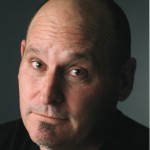Jon Scieszka (rhymes with Fresca) and Lane Smith grew up 2,000 miles apart, but their lives were on parallel tracks. Scieszka remembers hopping on his bike and riding to a field some place in Flint, Michigan with his five brothers. “We were out there playing dirt clod wars,” he says.
“Yeah! Dirt clod wars!” says Smith, awed by the sheer magic of his own dirt clod war memories in Corona, California.
They were destined to meet each other.
Cartoons like Speed Racer and Clutch Cargo shaped their early development. Monty Python, comic books, and MAD Magazine fine-tuned their silly, zippy, irreverent humor that sparkles with Scieszka’s words and Smith’s illustrations in all of their books, including the best-selling The True Story of the Three Little Pigs, Caldecott Honor Book The Stinky Cheese Man and Other Fairly Stupid Tales, and most recently, Science Verse.
Scieszka blames his particular brand of wackiness on a combination of Catholic school and military academy, plus “watching cartoons and sitting too close to the TV.” He graduated college with a premed background, but realized he didn’t like sick people. He attended Columbia University in New York City for his Master’s in fiction writing. After graduation he painted apartments. “That’s all you can do with a MFA in fiction writing,” he says. The twists and turns of fate found him teaching math and science to second and third graders, and opened up a whole new audience for his fiction.
Meanwhile, Smith attended Art Center College of Design in Pasadena, where he spent a lot of time in the library. “My favorite books were not [about] the Renaissance years, but the funky kids’ books.” After graduating, he left home and struck out for New York with a couple of portfolios and sheer determination. Doors opened for his work at the New York Times, Newsweek, Sports Illustrated, and Rolling Stone, yet every evening he perfected picture book illustrations for submission to children’s publishers. His first success wasHalloween ABC by Eve Merriam in 1989.
Scieszka and Smith met through their wives who worked together at a New York magazine. They hit it off immediately and began comparing notes. Scieszka’s stories were rejected because they were too weird and sophisticated. Smith’s drawings were too dark and sophisticated. They were perfect for each other.
After The True Story of the Three Little Pigs hit number one, Scieszka says “we challenged ourselves not to do another True Story book, but to ratchet it up.” Turning fairy tales upside down, The Stinky Cheese Man and Other Fairly Stupid Tales includes Little Red Running Shorts and The Princess and the Bowling Ball. Stinky Cheese Man also pokes fun at bookmaking with an upside down dedication page, a title page that screams TITLE PAGE, and end papers that are not at the end of the book. Smith’s wife, Molly Leach, is now a book designer and works closely with her husband and Scieszka meshing text, type style, art, and design for the now-trademark Scieszka/Smith “look.”
“For years I wanted to write a funny math book,” says Scieszka . “But I’d tell people that and they’d run away screaming.” Especially Smith. “I pictured drawing kids in desks—page after page of kids in desks,” says Smith. “Making everything geometrical and symmetrical.” An illustrator’s nightmare. Oddly, Smith’s worst-case scenario proved to be the key to unlocking Scieszka’s math book idea. Math Curse opens in Mrs. Fibonacci’s math class. “You know, you can think of almost everything as a math problem,” she says, laying the groundwork for the beginning of a math nightmare for the child narrator and the start of unlimited wild, surreal illustration possibilities for Smith.
Math Curse closes with a classic Scieszka/Smith gag—Mr. Newton, the science teacher says, “You know, you can think of almost everything as a science experiment. . .” Fan mail began rolling in with suggested versions for a sequel, Science Curse.
Readers have come to expect the unexpected from Scieszka and Smith. Their newest book,Science Verse (not Curse like readers expected), contains an entire science curriculum compressed into 21 poems. Some of the original poems borrow rhythm and structure from classics like “Jabberwocky” by Lewis Carroll, “The Song of Hiawatha” by Henry Wadsworth Longfellow, and “A Visit From St. Nicholas” by Clement Clarke Moore. For instance, “’Twas the Night” begins this way:
‘Twas the night before Any Thing, and all through deep space,
Nothing existed—time, matter, or place.
No stockings, no chimneys. It was hotter than hot.
Everything was compressed in one very dense dot.*
Scieszka and Smith’s appeal comes from the fact that they mess around as if they were kids—taking chances, challenging each other, solving problems, and testing the limits of possibility. Scieszka’s BeefSnakStik character from Squids Will Be Squids was one such challenge he set for Smith. What would a talking stick of beef jerky look like? “He’s beautifully realized,” says Scieszka. “Abrasive and belligerent.”
Scieszka and Smith’s next project is still unknown, but it’s guaranteed to be unexpected.
*From Science Verse by Jon Scieszka and Lane Smith, Viking, 2004.



